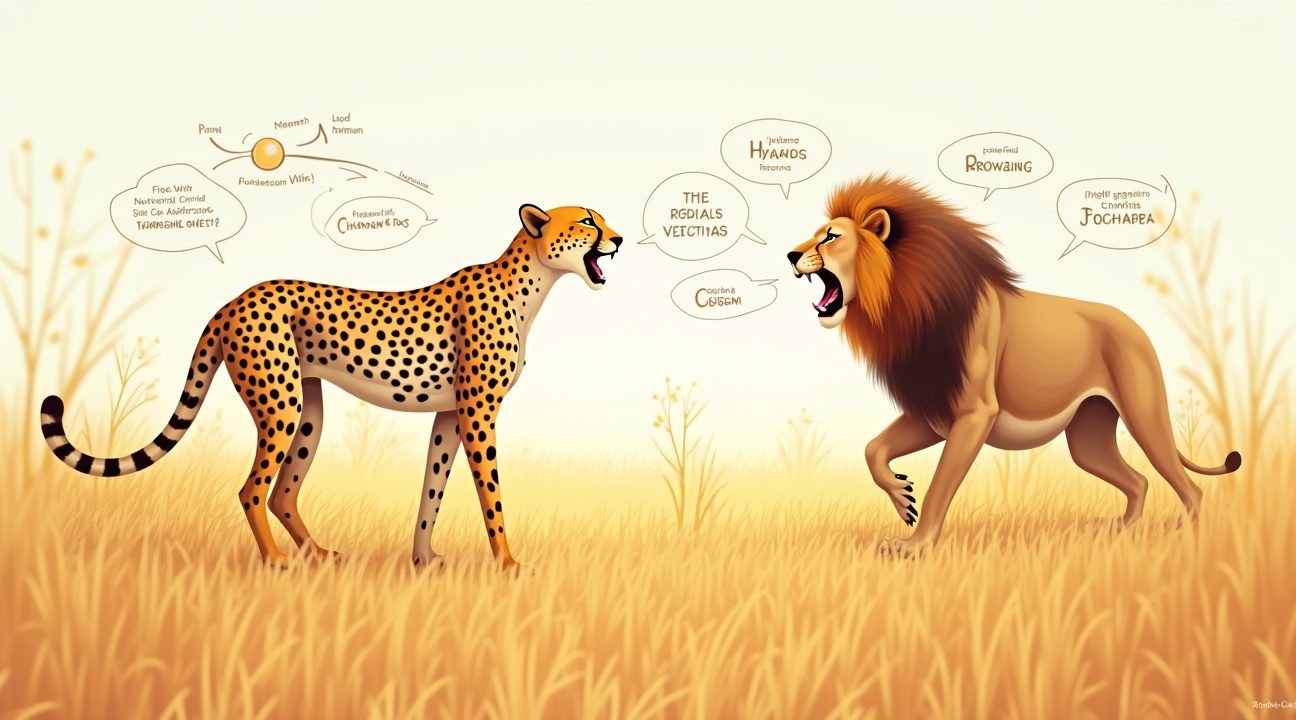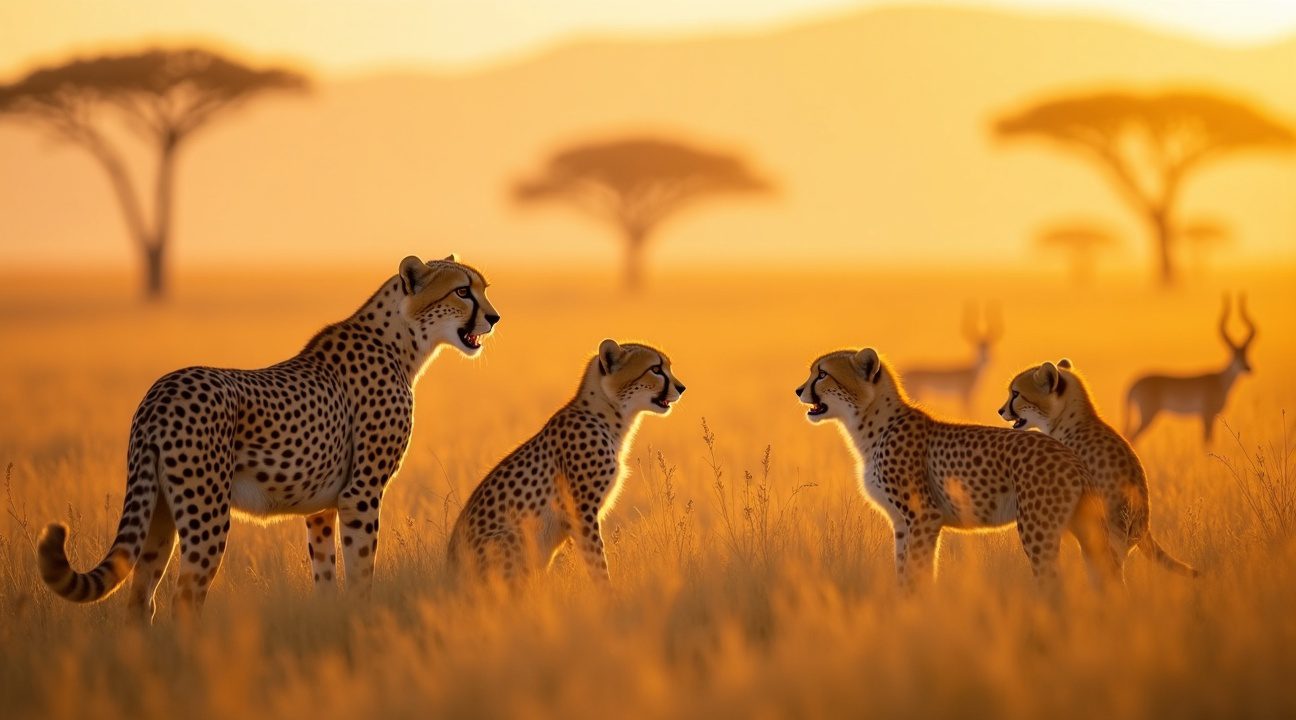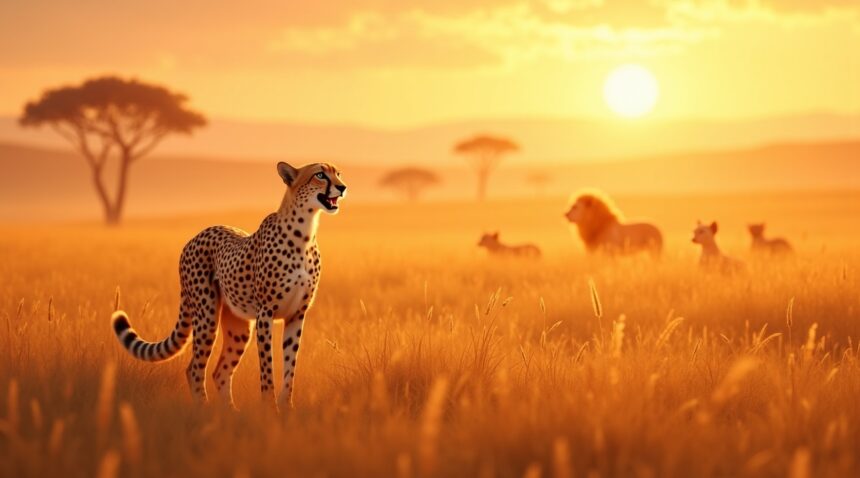Contrary to what many people expect from big cats, cheetahs cannot produce the thunderous roars that characterize lions, tigers, and leopards.
Instead, these remarkable spotted speedsters communicate through an entirely different vocal repertoire that includes meowing, purring, chirping, and chattering sounds remarkably similar to domestic house cats.
Key Takeaways
- Cheetahs lack the ossified hyoid bone structure that enables other big cats to roar; instead, they possess a flexible cartilaginous hyoid that produces entirely different vocalizations.
- Their primary communication sounds include high-pitched meows, long-distance chirps, audible purring, chattering during social interactions, and huffing when agitated.
- These quiet vocalizations serve their stealth-based hunting strategy perfectly, allowing family communication without alerting prey or attracting larger predators who might steal kills.
- Mother cheetahs use specific chirps and meows to guide cubs during hunting lessons and signal danger, with each sound traveling just far enough for family coordination.
- The vocal differences reflect cheetahs’ evolutionary focus on speed and agility over territorial dominance, making them unique among big cats in both physical capabilities and communication methods.
Anatomy Behind the Silence
The anatomy behind this vocal limitation lies in the cheetah’s hyoid bone structure. Other big cats possess a partially ossified hyoid apparatus with a flexible ligament that allows the larynx to drop low in the throat. This anatomical feature creates the resonating chamber necessary for producing deep, powerful roars that can travel for miles across the savanna.
Cheetahs evolved differently. Their hyoid bone remains completely cartilaginous and rigid, preventing the larynx from dropping into the optimal position for roaring. This structural difference forces them to rely on higher-pitched vocalizations that operate through different mechanisms entirely.
The Cheetah’s Vocal Toolkit
Meows
High-pitched meows function as contact calls between family members, particularly between mothers and cubs. These sounds carry just far enough to maintain group cohesion without broadcasting their location to potential threats.
Chirps
Chirping represents their longest-distance communication method. Mother cheetahs use these bird-like calls to locate cubs across greater distances, especially when cubs hide during hunts. The frequency and pitch of these chirps can convey different messages about urgency or specific situations.
Purring
Purring occurs during contentment and social bonding, much like domestic cats. Adult cheetahs purr when grooming each other or resting together. Cubs purr while nursing, creating a continuous feedback loop between mother and offspring.
Chattering
Chattering happens during social interactions, particularly when cheetahs encounter each other or during mating rituals. This rapid, staccato vocalization often accompanies visual displays and scent-marking behaviors.
Huffing
Huffing serves as an alarm call or expression of irritation. Cheetahs produce this sound when startled, threatened, or frustrated, often accompanying defensive postures or retreat behaviors.
Adaptations Aligned with Survival Strategy
These vocal adaptations align perfectly with the cheetah’s ecological niche and hunting strategy. Unlike lions who hunt in groups and defend territories through intimidation, cheetahs rely on stealth and speed. Loud roars would compromise their approach during hunts and potentially attract competing predators like lions or hyenas who frequently steal cheetah kills.
The quiet nature of cheetah vocalizations also reflects their vulnerable position in the predator hierarchy. Adult cheetahs weigh significantly less than lions, leopards, or hyenas, making direct confrontation extremely risky. Their survival strategy emphasizes avoiding conflict rather than advertising dominance through vocal displays.
A Tradeoff for Speed and Silence
This evolutionary path created a fascinating paradox among big cats. The fastest land animal sacrificed the most intimidating vocalization for anatomical features that maximize speed and agility. Their lightweight build, flexible spine, and specialized respiratory system all contribute to their incredible acceleration, but these same adaptations prevent them from producing the bone-rattling roars associated with apex predators.
Conservation Implications
Understanding cheetah vocalizations provides valuable insights into their behavior and conservation needs. These cats require vast territories to hunt successfully, and their quiet communication methods mean that human noise pollution can significantly impact their ability to coordinate family groups and locate mates.
Conservation efforts must account for these unique vocal characteristics when designing protected areas and wildlife corridors. Maintaining acoustic environments that support cheetah communication becomes as important as preserving adequate prey populations and habitat connectivity.
Whispers of the Savannah
The contrast between cheetah vocalizations and those of other big cats demonstrates how evolutionary pressures shape every aspect of an animal’s biology. Speed came at the cost of vocal intimidation, creating a predator that whispers rather than roars, chirps rather than bellows, and relies on stealth rather than acoustic dominance to survive in Africa’s competitive landscape.
The Big Cat That Breaks All the Rules: Why Cheetahs Meow Instead of Roar
I find it fascinating that cheetahs stand alone among their big cat cousins when it comes to vocal capabilities. These remarkable spotted cats cannot produce the bone-shaking roars that lions, tigers, and leopards are famous for. Instead, cheetahs communicate through an entirely different repertoire of sounds that includes meowing, purring, chirping, and chattering.
The Anatomy Behind the Silence
The reason cheetahs can’t roar lies in their throat structure, specifically their hyoid bone apparatus. Roaring big cats possess an ossified hyoid bone that creates the necessary anatomical framework for producing those powerful vocalizations. Cheetahs, however, lack this specialized laryngeal structure entirely. Their hyoid bone remains flexible and cartilaginous rather than becoming rigid and ossified like their roaring relatives.
This anatomical difference fundamentally changes how sound travels through their vocal tract. The flexible hyoid bone in cheetahs allows for a completely different range of vocalizations but prevents the deep, resonant roars that characterize true big cats. This structural variation is so significant that it places cheetahs in a separate category from the traditional “big four” cats — lions, tigers, leopards, and jaguars.
What Cheetahs Say Instead
Rather than roaring, cheetahs have developed a sophisticated vocal communication system that serves their unique lifestyle perfectly. Their primary vocalizations include several distinct sounds:
- High-pitched meows that sound remarkably similar to domestic cats but with more intensity
- Purring that’s audible from considerable distances, unlike the silent purrs of roaring cats
- Chirping calls that mothers use to communicate with their cubs across grasslands
- Chattering sounds during social interactions between siblings or potential mates
- Huffing noises when they’re agitated or warning other cheetahs
These vocalizations suit the cheetah’s solitary hunting style and open habitat preferences. Unlike team behaviors seen elsewhere in nature, cheetahs don’t need the intimidating roars that help lions establish territory or coordinate group hunts. Their communication system focuses more on mother-cub bonding and maintaining contact across the vast savannas where they live.
The cheetah’s inability to roar also connects to their overall physical adaptations for speed rather than strength. Just as celestial bodies follow specific patterns, cheetahs have evolved along a very specific evolutionary path that prioritized sprint capability over the vocal intimidation tactics used by other big cats.
This vocal limitation doesn’t disadvantage cheetahs in their natural environment. Their lightweight build, specialized hunting techniques, and unique communication methods work together as an integrated system. The meowing, purring, and chirping sounds they produce are perfectly adequate for their social needs and survival strategies.
Understanding why cheetahs can’t roar helps explain their position in the cat family tree. They represent a distinct evolutionary branch that chose speed and agility over raw power and vocal dominance. This makes them truly unique among the world’s big cats, standing apart not just in their hunting methods but in their fundamental anatomy and communication abilities.
The next time someone hears a cheetah’s high-pitched meow at a wildlife sanctuary, they’ll know they’re listening to a cat that has chosen an entirely different evolutionary strategy than its roaring cousins. These spotted speedsters prove that sometimes breaking the rules leads to extraordinary adaptations that allow species to thrive in their own distinctive way.

The Surprising Sounds Cheetahs Actually Make
Cheetahs produce an impressive array of vocalizations that might surprise anyone expecting the powerful roar of their larger feline cousins. I find it fascinating that these spotted speedsters communicate through sounds remarkably similar to domestic house cats, creating a vocal repertoire that’s both distinctive and unexpectedly familiar.
Meowing and Chirping: The Primary Cheetah Language
The cheetah meow stands out as perhaps the most striking vocalization these big cats produce. Much like a house cat comparison reveals, cheetahs emit soft, melodic meows that animal sanctuaries and zoos worldwide have documented extensively. These meows serve multiple purposes, from greeting other cheetahs to expressing contentment during social interactions.
Cheetah chirp sounds represent another crucial component of their communication system. These high-pitched calls carry across considerable distances, making them perfect for mothers calling to their cubs or adults coordinating during hunts. The chirping often sounds more like a bird than a large predator, adding to the unique character of cheetah vocalization patterns.
Natural recordings from wildlife reserves capture these sounds in various contexts, showing how cheetahs adapt their vocal intensity and frequency based on specific situations. Cubs respond eagerly to their mother’s chirps, while adults use different pitches to convey urgency or calm reassurance.
Trills, Yipping, and Other Expressive Sounds
Beyond meowing and chirping, cheetahs demonstrate remarkable vocal versatility through several other distinctive sounds:
- Trills create rolling, vibrant sounds that express excitement or contentment, particularly during social grooming sessions
- Yipping produces sharp, rapid bursts often heard during play or mild territorial disputes
- Purring generates the same rumbling satisfaction sounds that house cats make, typically during relaxed moments
- Hissing serves as a clear warning signal when cheetahs feel threatened or defensive
- Growling occurs during feeding time or when establishing dominance, though it lacks the deep resonance of lion or tiger growls
Animal experts like Keeper Kristy at Sydney Zoo provide valuable insights into these vocalizations, describing how pitch variations correspond to different emotional states and social scenarios. Her observations reveal that cheetahs adjust their vocal intensity based on proximity to other animals and environmental factors.
The trilling sound particularly captivates researchers and visitors alike. Cheetahs produce these expressive trills during positive social interactions, creating a musical quality that distinguishes them from other big cats. Mother cheetahs frequently trill to their cubs, establishing emotional bonds and providing comfort through vocal communication.
Recording equipment in wildlife facilities captures the subtle nuances of these sounds, revealing how cheetahs modify their vocalizations throughout different times of day. Morning chirps tend to carry further distances, while evening meows often sound softer and more intimate.
Professional keepers note that stressed or anxious cheetahs alter their typical vocal patterns, producing higher-pitched sounds or remaining unusually quiet. This behavioral insight helps wildlife caretakers assess the emotional well-being of cheetahs in their care.
The yipping behavior creates particularly interesting dynamics during group interactions. Young cheetahs frequently yip during play sessions, establishing social hierarchies through vocal exchanges rather than physical confrontation. Adult cheetahs reserve yipping for specific circumstances, making it a reliable indicator of their emotional state.
Understanding these diverse vocalizations helps researchers better appreciate how cheetahs have evolved sophisticated communication methods without relying on the intimidating roars that characterize other large predators. Each sound serves specific purposes, from maintaining family bonds to expressing territorial boundaries, creating a complex language system that’s uniquely suited to their ecological niche and social structure.
How Cheetah Vocalizations Compare to Other Big Cats
When I examine the vocal abilities of big cats, the differences become immediately apparent. Lions, tigers, and leopards all possess the remarkable ability to roar thanks to their flexible hyoid bone structure, while cheetahs cannot produce these thunderous sounds at all. Instead, cheetahs communicate through gentler vocalizations that might surprise anyone expecting the typical big cat experience.
The Roaring Champions vs. The Gentle Cheetah
A lion’s roar stands as one of nature’s most impressive acoustic displays, reaching up to 114 decibels and traveling as far as five miles away. This incredible volume allows lions to establish territory and communicate with pride members across vast distances. Tigers produce equally powerful roars that can be heard from similar distances, while leopards, though slightly quieter, still maintain the ability to project their voices far beyond what cheetahs can achieve.
Cheetahs operate on an entirely different vocal scale. Their meows, chirps, and purrs rarely exceed the decibel levels of typical household conversations. I find this fascinating because it reflects a completely different approach to survival and communication. Where other big cats announce their presence boldly, cheetahs prefer subtlety and discretion.
Evolutionary Adaptations Behind the Silence
The contrast in vocal abilities directly relates to each species’ hunting strategies and social structures.
- Lions hunt in coordinated groups and need powerful roars to maintain territorial boundaries and coordinate pack activities.
- Tigers use their vocalizations to claim vast territories and attract mates across dense forests.
- Cheetahs, on the other hand, have evolved along a different path entirely.
As primarily solitary hunters who rely on incredible speed and stealth, cheetahs don’t require loud territorial calls that might alert prey or competitors to their location. Their softer vocalizations serve perfectly for close-range family communication between mothers and cubs or brief interactions between adults.
This vocal difference also reflects their physical build priorities. While other big cats developed powerful vocal cords and supporting structures for roaring, cheetahs invested their evolutionary resources into lightweight frames, efficient respiratory systems, and incredible acceleration capabilities. The trade-off means they sacrifice vocal power for physical performance.
The limited range of cheetah calls actually provides practical advantages for their lifestyle. Short-distance communication prevents them from attracting unwanted attention from larger predators like lions or hyenas who might steal their kills. Understanding the impact of these evolutionary choices helps explain why cheetahs thrive despite seeming disadvantages.
Their meowing sounds remarkably similar to domestic cats, which makes sense given their shared ancestry. Cheetahs also produce chirping sounds that resemble bird calls, particularly when mothers communicate with their cubs. These vocalizations carry just far enough to maintain family bonds without broadcasting their location to potential threats.
The decibel level differences between cheetahs and other big cats highlight how form follows function in nature. While a tiger’s roar might shake the ground, a cheetah’s gentle chirp accomplishes exactly what it needs without compromising the animal’s survival strategy. Rare footage of deadly square waves demonstrates how nature often surprises us with unexpected adaptations.
This vocal comparison reveals that louder doesn’t always mean better in the animal kingdom. Cheetahs have successfully carved out their niche by embracing stealth over strength, speed over size, and whispers over roars. Their unique position among big cats proves that evolutionary success comes in many different forms, each perfectly suited to its environment and lifestyle requirements.
https://www.youtube.com/watch?v=U_k_PAZxsys

Why Meowing Makes Perfect Sense for Cheetahs
I find it fascinating how cheetah vocalizations perfectly match their survival strategy. Unlike the thunderous roars that announce a lion’s presence across the savanna, cheetahs have developed a communication system that prioritizes discretion over dominance. Their meows, chirps, and other high-frequency sounds serve as sophisticated tools for maintaining family bonds while keeping them hidden from threats.
Mother-Cub Communication Through Soft Sounds
Cheetah mothers rely heavily on meowing to communicate with their cubs during those critical early months. I’ve observed that these gentle vocalizations help cubs identify their mother’s voice among the subtle sounds of the grasslands. When a mother needs to signal her cubs to follow her to a new den site or warns them of approaching danger, she uses specific chirps and meows that travel just far enough to reach her young without alerting predators or competitors to their location.
These vocal exchanges become even more important when cubs are learning to hunt. Mother cheetahs use quiet meows to guide their offspring during practice sessions, teaching them when to advance or retreat. The precise timing of these communications mirrors the careful coordination seen in other animal behaviors where silence and subtlety prove more valuable than bold displays.
Stealth-Based Survival Through Vocal Adaptation
The cheetah’s reliance on stealth hunting makes their meowing behavior an essential survival adaptation. While a lion’s roar can travel up to five miles and serves to establish territory, cheetahs need vocalizations that won’t compromise their hunting success. I understand that these cats depend on surprise attacks rather than intimidation, making loud roars counterproductive to their hunting strategy.
Cheetah communication includes several distinct sounds that serve different purposes:
- Chirps for long-distance contact calls between family members
- Soft meows for close-range interactions and reassurance
- Purring during grooming sessions and bonding moments
- High-pitched yelps when expressing distress or excitement
- Stuttering sounds during greetings between familiar individuals
Each vocalization type allows cheetahs to maintain social connections without broadcasting their location to hyenas, leopards, or lions that might steal their kills or threaten their cubs. This vocal strategy reflects millions of years of evolution favoring cats that could communicate effectively while remaining undetected by larger predators.
Solitary adult cheetahs also benefit from these quiet communication methods. When males form coalitions or when females encounter each other at territorial boundaries, they can assess each other’s intentions through subtle vocalizations rather than aggressive displays. I notice this behavior particularly aligns with how natural systems often develop efficient solutions that serve multiple purposes simultaneously.
The frequency range of cheetah meows and chirps travels well through grassland environments without creating the low-frequency vibrations that might alert prey animals. This acoustic adaptation proves especially valuable during dawn and dusk hunting periods when sound travels differently through the cooler air. Female cheetahs raising cubs benefit enormously from this system, as they can maintain contact with their young while remaining invisible to the numerous threats that target vulnerable cheetah families.
Cheetah vocalizations represent a perfect example of how evolution shapes behavior to match ecological requirements. Rather than developing the powerful vocal apparatus needed for roaring, cheetahs invested their evolutionary energy into speed, agility, and communication systems that support their unique hunting style. Their meows might sound gentle compared to a lion’s roar, but they represent millions of years of refinement toward a specialized survival strategy that has kept cheetahs successful in challenging African ecosystems.

Sources:
Sydney Zoo – “Cute Cheetah Sounds: Enjoy These Adorable Meows and Chirps”
Toronto Zoo – “Cheetah Awareness Day – Vocalizations”
Cute Baby Animals – “Cheetah Meowing are Super Cute – Cheetah Meow Sound”
Eugenie Wild Vet – “Cheetah’s Unique Sound: A Surprise Meow Revealed”
Wild Cats World – “Cheetah says ‘Meow!'”


